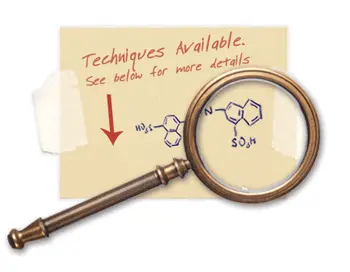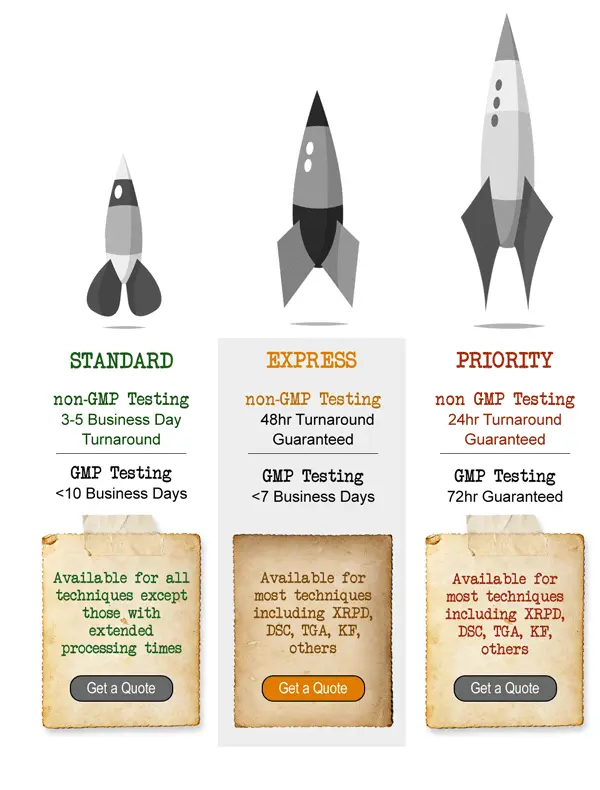Contract Research Services for High Performance Liquid Chromatography (HPLC), Ultra High Pressure Liquid Chromatography (UPLC), Thin Layer Chromatography (TLC), and Gas Ghromatography (GC) with Headspace Analysis.
Triclinic Labs has extensive experience in analytical chromatographic separations for simple to complex projects. Analytical chromatography relies on small amounts of material and strives to measure the relative or absolute amounts of analytes in a mixture based on differences in physical or chemical properties. We routinely conduct projects for:- Actives Quantitation (Potency)
- Additive Analysis
- Extractables and Leachables
- Unknown Volatile Identification
- Reverse Engineering
-
Reproduction of Patent Examples, Prior Art,
Infringement Analysis - Assay and Impurity Analysis
- Identification including Contaminant Analysis and
-
Quantitative Method Development, Transfer, and Validation
We are well versed in handling and analyzing:
- Solid oral medications (tablets & capsules)
- Liquids & semi-liquids
- Topicals
- Emulsions
- Creams
- Microspheres
- Dispersions
- Food products
- Medical Devices
- Cosmetics - including plant-based products
Types of chromatography we offer:
- HPLC
- UPLC
- GC
- TLC
Ask Our Scientists!
Request More Info

Separation Science
High Performance Liquid Chromatography (HPLC)
HPLC is a form of column chromatography that pumps a sample mixture or analyte in a solvent (known as the mobile phase) at high pressure through a column with chromatographic packing material (stationary phase).
HPLC has the ability to separate, and identify compounds that are present in any sample that can be dissolved in a liquid in trace concentrations as low as parts per trillion. Because of this versatility, HPLC is used in a variety of industrial and scientific applications, such as pharmaceutical, environmental, forensics, and chemicals. Sample retention time will vary depending on the interaction between the stationary phase, the molecules being analyzed, and the solvent, or solvents used. As the sample passes through the column it interacts between the two phases at different rate, primarily due to different polarities in the analytes. Analytes that have the least amount of interaction with the stationary phase or the most amount of interaction with the mobile phase will exit the column faster.We offer the following types of column chromatorgaphy:
Hydrophobic Interaction Chromatography (HIC)
Hydrophobic Interaction Chromatography (HIC) also separates molecules according to their hydrophobicity. Unlike RPC, HIC is a useful separation technique for purifying proteins because it utilizes less denaturing conditions helping to preserve the biological activity of the proteins.
Ion Exchange Chromatography (IEC)
Ion Exchange Chromatography (IEC) involves the separations of charged molecules which binds to oppositely charged molecules in the column. With this method, it is possible to separate molecules with even small differences in charge by choosing the optimal ion exchanger and separation conditions.
Size Exclusion Chromatography (SEC)
Size Exclusion Chromatography (SEC) is the simplest chromatography method that separates molecules according to their size and thus is used to separate large molecules. SEC is very flexible and can be used with aqueous solutions (gel filtration chromatography) or organic solutions (gel permeation chromatography) and allows you to choose the optimal conditions for your sample. Another advantage is that, in certain experimental conditions, it is possible to determine approximate molecular weight. It is usually applied to separate macromolecules such as proteins, polysaccharides or industrial polymers.
Multi-modal or mixed-mode Chromatography (MMC)
Multi-modal or mixed-mode Chromatography (MMC), is a chromatographic method which combines two or more types of chromatography to complete the separation of components. The combination of several separations can give MMC a higher selectivity.
| Instrument Brand | Model | References |
| Agilent |
1100s and 1260 Infinity IIs with Chromelon 7.2 software Detectors: diode array, refractive index, light scattering |
Wiki Reference for HPLC |
Ultra High Performance Liquid Chromatography (uHPLC):
Where standard HPLC typically uses column particles with sizes from 3 to 5µm and pressures of around 400 bar, uHPLC use specially designed columns with particles down to 1.7µm in size, at pressures in excess of 1000 bar. The main advantage of an uHPLC is speed. These systems are faster, more sensitive, and rely on smaller volumes of organic solvents than standard HPLC, resulting in the ability to run more samples in less time.
Gas Chromatography
Gas chromatography is a term used to describe the group of analytical separation techniques used to analyze volatile substances in the gas phase. In gas chromatography, the components of a sample are dissolved in a solvent and vaporized in order to separate the analytes by distributing the sample between two phases: a stationary phase and a mobile phase. The mobile phase is a chemically inert gas that serves to carry the molecules of the analyte through the heated column. Gas chromatography is one of the sole forms of chromatography that does not utilize the mobile phase for interacting with the analyte. The stationary phase is either a solid adsorbant, termed gas-solid chromatography (GSC), or a liquid on an inert support, termed gas-liquid chromatography (GLC).
Residual solvents analysis is a major component of GC testing. Previously referred to as organic volatile impurities (OVIs), residual solvents are trace level chemical residues that are used or produced in the manufacture of drug substances and excipients or in the preparation of drug products. They can also be byproducts formed during packaging and storage of the drug product.
| Instrument Brand | Model | References |
| Thermo Electron |
Trace 1310
Separation and analysis of complex mixtures |
Wiki Reference for Gas Chromatography |
Thin-layer chromatography (TLC)
TLC is a very commonly used technique in synthetic chemistry for identifying compounds, determining their purity and following the progress of a reaction. It also permits the optimization of the solvent system for a given separation problem. In comparison with column chromatography, it only requires small quantities of the compound (~ng) and is much faster as well. A stationary phase, a special finely ground matrix (silica gel, alumina, or similar material) is coated on a glass plate, a metal or a plastic film as a thin layer (~0.25 mm). In addition, a binder like gypsum is mixed into the stationary phase to make it stick better to the slide. In many cases, a fluorescent powder is mixed into the stationary phase to simplify the visualization later on (e.g. bright green when you expose it to 254 nm UV light). Known samples and unknown samples are spotted on to the slide for separation.
The components, visible as separated spots, are identified by comparing the distances they have traveled with those of known reference materials. Sample recovery and identification using an orthogonal technique is often used.
Dissolution Testing
Dissolution testing is a requirement for all solid oral dosage forms and is used in all phases of pharmaceutical development for product release and stability testing. It is a key analytical test used for detecting physical changes in an active pharmaceutical ingredient (API) and in the formulated product.
We commonly use VanKel dissolution equipment and Apparatus 1 (Basket) and Apparatus 2 (Paddle). We typically perform analyses at predetermined sample intervals using HPLC, UV-VIS Spectrophotometry, and other analytical techniques. We offer cGMP dissolution support for APIs and a wide variety of dosage forms in various media systems, including biorelevant media.
Chromatography Service Levels Available:

